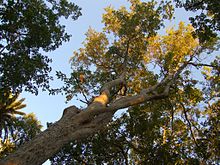| Acer oblongum | |
|---|---|

| |
| Conservation status | |
 Least Concern (IUCN 3.1) | |
| Scientific classification | |
| Kingdom: | Plantae |
| Clade: | Tracheophytes |
| Clade: | Angiosperms |
| Clade: | Eudicots |
| Clade: | Rosids |
| Order: | Sapindales |
| Family: | Sapindaceae |
| Genus: | Acer |
| Section: | Acer sect. Pentaphylla |
| Series: | Acer ser. Trifida |
| Species: | A. oblongum |
| Binomial name | |
| Acer oblongum Wall. ex DC. (1824) | |
| Varieties | |
| |
| Synonyms | |
List
| |
Acer oblongum, common name Himalayan maple, evergreen maple and Kashmir maple, is an evergreen Asian species of maple in the family Sapindaceae.
Description
Acer oblongum is a medium-sized evergreen to semi-deciduous tree reaching a height of approximately 15–22 metres (49–72 ft). Unique among maples, this plant stays green all winter. The trunks are buttressed, with a smooth to wrinkled bark. Leaves are opposite, ovate-lanceolate with entire margin, with a petiole 5–12 cm long, with glaucous-green underside and dark green upperside. The young shoots are reddish bronze and finely hairy. The flowers are hermaphroditic, small and inconspicuous, about 4 mm, greenish white, gathered in hairy racemes. The fruits are represented by the typical two-winged samaras, about 2.5 cm long, wind dispersed. It has been introduced for its wood and it is sometimes cultivated in large gardens for its evergreen foliage.
Distribution
Acer oblongum is widespread across central, eastern, and southeastern Asia, from Tibet and northern India east as far as Japan, including southern China, and northern Indochina.
Varieties
Three varieties are accepted.
- Acer oblongum var. itoanum Hayata – Ryukyu Islands
- Acer oblongum var. oblongum – northeastern Pakistan to central and southern China and northern Indochina
- Acer oblongum var. omeiense W.P.Fang & Soong – Sichuan
Habitat
Acer oblongum prefers humid climate of the Himalayan forests, especially along streams, at an elevation of about 600–2,000 metres (2,000–6,600 ft) above sea level.
References
- Barstow, M.; Crowley, D.; Rivers, M.C. (2017). "Acer oblongum". IUCN Red List of Threatened Species. 2017: e.T62941A3117072. doi:10.2305/IUCN.UK.2017-3.RLTS.T62941A3117072.en.
- ^ "Acer oblongum Wall. ex DC". Plants of the World Online. Royal Botanic Gardens, Kew. Retrieved 15 October 2024.
- The Plant List, Acer oblongum Wall. ex DC.
- "Himalayan maple". Flowers of India. Archived from the original on 28 February 2012. Retrieved 31 January 2023.
- Philips, Roger (1979). Trees of North America and Europe. New York: Random House, Inc. ISBN 0-394-50259-0.
- Flora of China, Acer oblongum Wallich ex Candolle, 1824. 飞蛾树 fei e shu
- Notes from the Royal Botanic Garden, Edinburgh. Edinburgh and Glasgow 8:329. 1915
External links
 Data related to Acer oblongum at Wikispecies
Data related to Acer oblongum at Wikispecies- Oregon State University
- Dipbot, Hortus Botanicus Catinensis, Botanical Department - University of Catania photo
- "Acer oblongum". Plants for a Future.